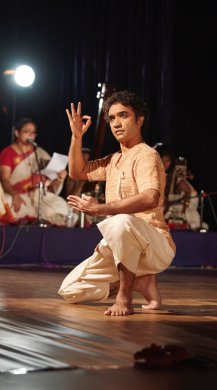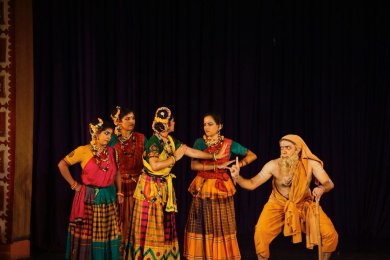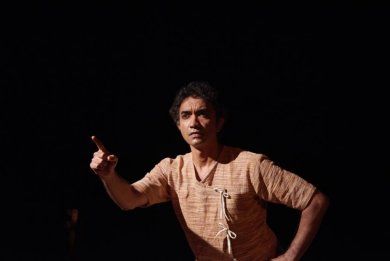
|
 |

|
 |
CP Satyajit: Information is information, not knowledge - Thushyanthy Velauthan e-mail: v.thushy@yahoo.com December 14, 2017 C.P. Satyajit, as an experienced Bharatanatyam dancer, a yoga practitioner and a professional photographer playing 3 roles in his career, shared some interesting insights on his recent visit to Sri Lanka to perform in 'Aum Shiva Muruga' dance drama to raise funds for the re-construction of Thiruketheeswaram temple, Mannar. Satyajit learned dance from his parents, The Dhananjayans, and since his dance debut in 1988, he has been performing Bharatanatyam all over India and abroad. His creation 'Mounakkural', a dance drama on women commissioned by the British Council to commemorate the UN women's conference in Beijing has received accolades. He is also experimenting and sharing experiences of yoga in dance. He has been working in the field of photography, mainly engaged in advertising related photography, which include: automotive, architecture, interiors, fashion, food, jewelry etc.  The dance you were learning from your parents for many years and the dance you wanted to create / choreograph... do you differentiate? I can tell you an example to explain this. Once while we were practicing for a program, suddenly I realized dancers are not internalizing the rhythm. That was 'thisra alarippu' which all dancers learn in the beginning. What I did was I requested 6 dancers to perform in complete silence without nattuvangam. The first 5, 6 times they were lost. Then they slowly started to feel the rhythm from universal energy which can bind all 6 dancers together. Audience were sitting on the edge of the seat and looking for what will happen next and it created lots of expectation in the audience. Here the purpose is not to do anything different, but to increase some intensity. If we ask children to dance in darkness, what will happen? They will become more aware of their body positions and movements. Basically, it is looking deeper into where it comes from and what it gives. Rather than doing to attract the audience externally, or learning superficially, if you really want art to reach people and change people, dancers have to go internally and work with the self a lot. So, the practices are the difference but the roots are same. Most of us theoretically know and understand or maybe try to imbibe that dance and yoga is similar path. Both have actions and beyond actions. What is the basic link which is connecting these ancient arts? It is a tough question, because in these two paths, still we are discovering many things...we feel there is something connecting dance and yoga which is difficult to put into a theoretical syllabus or construct a limited definition. One of my seniors said that if we consider dance as a straight line, yoga is a beautiful thread which is going through the line of the dance and we feel a richness of fullness in it. For example in yoga there are asanas and breathing practices etc... how can we let that surround us as dancers. Even though we have much potential, we have treated the performing arts with goal oriented feelings with limitations. Yoga is an art that we deeply absorb to find out our inner self and not for a demonstration or for a performance. It is a practice for the self where our mind and body become a seeker to find our altruistic needs. In that way dance has taken a different route nowadays, because it is glamourous, and it has the character to entertain and attract people easily. We have taken an easy route. Of course,there are people who work a lot in dance. But I feel it is more essential now than ever before that we have to start pushing and encourage people to looking inward because the entire problem that we are seeing in today's world is we can't always be externalized. At some point we have to realize that I am also a cause for this. And when each and every person has to start to understand and feel that we have to push this art into a deeper space for introspection, then only we can heal the world by these arts. Healing of the self starts with introspection. In introspection first you meet yourself with some negativities; it starts with pain and sorrow. There may be goodness in the pain also...the philosophy of this is very deep. In this surface we can use and facilitate yoga to practice dance deeper. Not just practice but also train and teach children. For example, how do they feel about aramandi (half sitting pose), samapatham (standing pose)? What is the understanding of samapatham, what is in standing straight? What is in their sights? How do they connect with the audience in a single pose? Small, simple thing... So, the inner vibration should reach the outer world. Most of the time, we are using written context and music quite unnecessarily, but not letting our body and inner vibration connect with people. This needs effort. And that's where the dance and yoga is linking together. For example if someone is performing "Enna thavam seithanai," everybody knows the feeling in it, so we have to do very little movements... the song has already created the purpose. Sometimes we overuse music and movements that we tend to forget what we have to share through the performance. In this yoga helps us. In my production 'Gandhi,' I didn't show Gandhi's physical gestures and appearance. We explored the ideas that Gandhi talked about and how it is relevant to the present moment. I would say introspection and connection are important basic lines in dance and yoga. 

While dancing, how should dancers handle their breathing? Breathing is very personal as everybody has different relationship with breath. In yoga, the first step and awareness is breath which causes some effects on your mind, body and movements. I think it will be a good idea to introduce breathing practices and after a certain period it is up to the students to find out how it is working according to their metabolism. Similarly, the cause for a headache differs from person to person; the rhythm of the breath also differs dancer to dancer when they are dancing. A dancer should become aware of his or her breathing and by continuously observing they can handle when they are dancing. Initial step is to calm down the mind and focus and find out the balance. We introduced a program named 'Ramyam' to the children, basically to practice dance with yoga. We did the prayer slokam, in a very slow motion of one word and inhale and another word with exhale. There is an action with breathing exercise, the body understands naturally where we have to inhale and exhale. Once you let go of controlling yourself of thinking of the output which you are going to receive for your input or limiting anything doing result oriented, your breath will flow naturally without being uncomfortable. In one program we made the dancers speak in-between the performance. So it created more awareness of the situation where after a hard movement they will have to speak. The reality of the situation that they went through is the real achievement from dance. That will talk to the audience. We have trained the children to do fake things. When we train children, we don't train them with reality which is the one going to connect and last. The reality should come from inside and that will reach a high level. By observing the rhythm of breathing, dancers can handle or balance their breath naturally while dancing. Dance is to bring lightness and happiness into our lives. And it is a very powerful tool of healing, powerful source of knowledge, powerful treasure to be protected. Sometimes I see Gurus and students are undergoing stress, before and also after the performances. Where are we lacking? There are artistes who have performed for 5 to 6 hours. Nothing happened to them. Nobody felt any hardness or stress in it. The philosophy of dance is it brings the beauty of sharing and making each other closer in the society. The root cause we are lacking is admiring the art. We are losing the art of 'Rasikathuvam.' The real rasikas (spectators/audience) are very few. There are art consumers now. When everything is going to the low extent, artist is also under stress. I am compelled to do something. Why can't I say I have got this opportunity but I am not ready to perform today?... I need time...are we saying it? But we are compelled to do it; this is my profession, my reputation. If I don't perform today, next time they will not call me for the program. All these social conditions, we bring into the art and that makes us to undergo stress. We do programs with 1 or 2 rehearsals...but the magic that's going to come after 10 rehearsals is lost. We brought some formulas of 'limited time maximum result'...all these causing stress.... why can't we say that we need time to inculcate it...5 people or 5000 audience, what judgment do we give to the quality of our art ? For example, Nrityagram, one of the Odissi dance schools in Bangalore... they live outside the city, they practice dance, do farming, do yoga, they live a life of art and bring the real attitude of art in planting and in other actions also. Creativity in all...their quality didn't come in overnight, it is practice of many years.  In the early days, Guru decided what was to be taught to students as per their maturity and capacity and when. Nowadays most people know many things about dance. They see, hear from all corners of the world. They quickly learn a piece and perform and forget about it also. On the other hand we see new dimensions, technology and more opportunity to learn. Amidst this the journey of pure art has to reach its highest goal. How do you see these changes? There are many levels of reactions to this change. First reaction is that we understand there are changes. Not only in this particular field, in everything including parenting. Information is information, not knowledge. It will take time to change from the informative level to knowledgeable level. We feel, if I didn't use this costume, no one will appreciate. If I didn't use this music, program will not be successful. If I didn't use this light, it won't look great. This will lead to comparing which will result in lot of conflict in a presentation. We are looking for something small and not taking time to feel and stay in it. We all can see the small clips of dances in Youtube or FB that will give only information but will not make you a knowledgeable person. The role of teachers and gurus is not to produce dancers to create their market, but to feed the ability to choreograph items.We are talking with guru, deep issues which are inside us. When a student starts to create on his own, that is the real graduation. A student comes to the guru in search for deeper things. Not to learn items only. That they can do anyway. But if they can bring the item that they have created and to discuss deeper insights which the guru can offer them, that is the traditional way of this art. I don't think all the modern changes are necessary to learn this art. These conveniences from modernity will not give the experience of hard work or learning of coming out of the inconveniences. Thushyanthy Velauthan is a professional attached to the Embassy of Switzerland to Sri Lanka and Maldives, also a Bharatanatyam dancer and writer. She organizes cultural events with the collaboration of government and non government institutions. Post your comments Unless you wish to remain anonymous, please provide your name and email id when you use the Anonymous profile in the blog to post a comment. All appropriate comments posted with name & email id in the blog will also be featured in the site. |